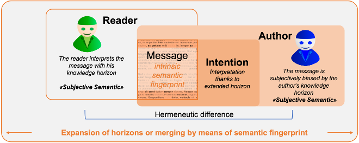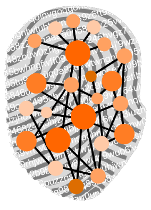Hermeneutics
Hermeneutics is the theory of interpretation and interpretation of texts and understanding. That is, semantic analysis as we commonly call it today.
In understanding, man uses symbols. He is involved in a world of signs and in a community that uses a common language. There is meaning not only in texts, but in all human creations. To unlock this is a hermeneutic task. In our methods and explanations we also call this semiotics.
In antiquity and the Middle Ages, hermeneutics served as the science and art of interpreting fundamental texts, especially the Bible and laws.
In modern times, it's scope expanded. It developed into a general doctrine of the prerequisites and methods of proper interpretation and into a philosophy of understanding.
Hans-Georg Gadamer is considered the most influential representative of philosophical hermeneutics in the 20th century; he placed understanding in the context of a conversation about the interpretation of important testimonies of historical and cultural tradition, which in principle cannot be terminated.
Speech: Hermeneutic with semantic Fingerprint (German) LINK
Semiotics
Semiotics, sometimes also sign theory, is the science that deals with sign systems of all kinds (e.g. pictorial writing, gestures, formulas, language, traffic signs). It is applied, among others, in various humanities, cultural studies, economics and social sciences.
In text-oriented linguistics, semiotics describes the fact that two messages with identical syntax can have different semantic meanings. The semantics is strongly influenced by time, place and the external circumstances of these messages.
Semiotics thus stands in a triangular relationship between syntax (the study of signs), semantics (the meaning and content of linguistic strings, words, sentences, or texts), and pragmatics (relation to time and place). Charles W. Morris developed the classical tripartite division into syntax - semantics - pragmatics: syntax as the relations between signs, semantics as the relations between signs and their meaning, and pragmatics as the relation between signs and users. In the case of users, we go one step further and say: the relationship to the user is automatically connected to the place where the user composes the message and to the time when he composes the message. A message that stands in space without any contextual connection or additional information about the author is difficult to interpret, especially if the message itself has no strong intrinsic semantics.
Intrinsic Semantics
Intrinsic semantics is the semantics of a text when it is not read!
Let us assume that we have a text that is unknown to us and of which we have no information about its origin or its author. Thus, there is also no reference to other texts. Nevertheless, this text has a semantics and a message. We call this the intrinsic, inherent, or inherent semantics because of the grammar and stylistics used in writing the text.
Hans-Georg Gadamer describes in his publications the following thesis: When one approaches a text, one has a certain pre-understanding, a mental imprint. This means the knowledgehorizon of a reader, his knowledge and his experiences and thus his understanding of the world. When he reads the text, a first understanding of the text develops. Thereby the reader expands his horizon and thus also his pre-understanding. From this new pre-understanding, an expanded, corrected, or new understanding of the text emerges as the reader continues to engage with the text. If this process is continued, an infinitely continuous progress of knowledge takes place.
One must first understand the text and its world of thought before one can translate it correctly - but in order to understand it, one must first translate it. This is called a "hermeneutic circle." Gadamer uses the hermeneutic circle to describe the theory that the whole must be understood from the individual and the individual from the whole.
Thus, the hermeneutic circle contains a paradox: that which is to be understood must have been understood somehow before.

Semantic Fingerprint
The semantic fingerprint is the transformation of the intrinsic semantics of a text into a multidimensional vector space for storage and automated processing
In a process continuously optimized by Deep Learning, the software creates a digital twin of the text searched for by the respective user or, subsequently, even of the user himself with regard to his fluctuating needs for information, sources, security and accuracy.
Starting from the intrinsic semantics of the text, an arbitrary number of further features are defined for the creation of the semantic fingerprint, standardized and mapped in a multidimensional vector space as data points (corresponding to the papillary ridges of the biological fingerprint).
In addition to the intrinsic features of the text, which are primarily defined by the frequency or exclusivity, the positioning, and the interconnectedness of its "supporting words", contextual parameters such as information about time, place, and author, his motivation, as well as plausibility, statement, and reality reference of the message are added. The number of dimensions in the vector space for the semantic fingerprint is up to 100,000.
The Fingerprint Similarity Score (FPSS), a value between zero (no match at all) and one (total match), is used to compare digitally retrieved texts with the semantic fingerprint that is being "searched" for. All values in between represent the graded match.

Semantic fingerprints can be easily and quickly compared with conventional computer systems. Millions of fingerprints can be compared in just a few minutes.
Copyright © by BII-Institute 2013-2021, info@diwa-capital.com | SWISS MADE |